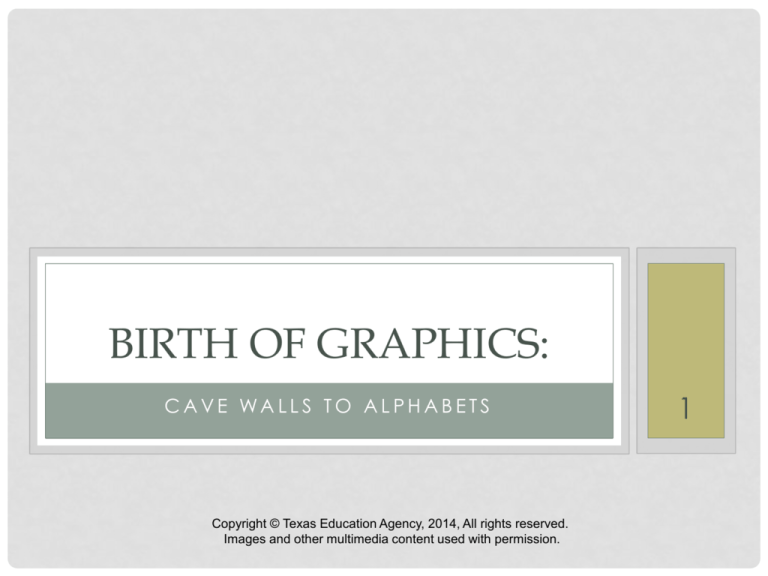
BIRTH OF GRAPHICS:
CAVE WALLS TO ALPHABETS
Copyright © Texas Education Agency, 2014, All rights reserved.
Images and other multimedia content used with permission.
1
WHAT ARE GRAPHICS?
Graphics are a visual representation of something
intended.
• Visual representation is drawing, sketching, carving,
painting or otherwise showing something intended.
• Visual representation depicts people, places, things,
idea, concepts, emotions, images or abstractions.
• Alphabets and writing are forms of visual
representation.
Copyright © Texas Education Agency, 2014, All rights reserved.
Images and other multimedia content used with permission.
2
WHERE DID VISUAL REPRESENTATION
BEGIN?
• Some of the first known (oldest) visual representations
are found in caves in Lascaux, Spain.
• It was the first visual documentation.
Photo from http://viewoncanadianart.com/
Copyright © Texas Education Agency, 2014, All rights reserved.
Images and other multimedia content used with permission.
3
CAVE WALLS FOR AN ARTBOARD!
• A cave dweller was inspired to pick up a rock, decaying
stick or perhaps charcoal and draw images of things he
or she had seen.
• Many of the drawings on cave walls depict animals and
hunting – and in some cases, life in general.
• Whoever was compelled to draw probably had no idea
how impactful or far reaching their actions would be!
Copyright © Texas Education Agency, 2014, All rights reserved. I
mages and other multimedia content used with permission.
4
NEXT WERE PETROGLYPHS
• Writing, sketching or
drawing on Rock
Photos from en.wikipedia.org
Copyright © Texas Education Agency, 2014, All rights reserved.
Images and other multimedia content used with permission.
5
CIVILIZATION BEGINS…
MESOPOTAMIA CONTRIBUTIONS
The beginning of civilization is believed to be in
Mesopotamia.
• Means “land between rivers.
• Modern day Iraq, Kuwait & part of Syria
• Often called the “Cradle of Civilization.”
• First organized society.
Copyright © Texas Education Agency, 2014, All rights reserved.
Images and other multimedia content used with permission.
6
NEEDS ARISE AND ARE MET THROUGH
VISUAL REPRESENTATION
Some important areas:
Ownership & Authority
Cylinders with unique
design signatures
were used to show
authority, grant
permission, seal or
mark items.
Photo from British Museum
Laws
Inventory
This clay tablet holds a
grid which records the
amount of silver in the
palace.
Photo from commons wikipedia.org
History
Hammurabi’s Code of Law which recorded all laws on a
stone stele and placed it in a
public place. These laws were
to be followed by the society.
Everyday life was recorded and
documented. Religious edicts
were written down. Kings and
battles were recorded.
Photo from British Museum
Copyright © Texas Education Agency, 2014, All rights reserved.
Images and other multimedia content used with permission.
Photo from en wikipedia.org
7
LET’S COUNT AND WRITE!
• With thriving villages, societies needed
ways to label and identify grains and
goods.
• They needed ways to exchange products
and services fairly.
• They needed ways to consistently record
history and information.
Copyright © Texas Education Agency, 2014, All rights reserved.
Images and other multimedia content used with permission.
8
FOR RECORD KEEPING
• Simple symbols and counting systems
developed. Lines and marks had
specific meaning for goods and
amounts.
http://historicconnections.webs.com/
• Numbers began to evolve for fair
exchange and accounting.
Copyright © Texas Education Agency, 2014, All rights reserved.
Images and other multimedia content used with permission.
9
POPULATIONS GROW &
ALPHABETS EMERGE…
Hieroglyphics
Cuneiform
It used a wedge like
impression to make
letters for sounds and
to represent words.
Photo from British Museum
Egyptian form of writing
that used pictures. Most
often seen in tombs or on
containers.
Photo from en wikipedia.org
Chinese
Greek
The beginning of the
alphabet as we know it
today. Many letters are still
used.
Photo from http://www.buzzle.com/
Used calligraphic strokes to
indicate thoughts and
ideas. There is very close
relationship between meaning
and structure of characters.
Photo from simple.wikipedia.org/
Copyright © Texas Education Agency, 2014, All rights reserved.
Images and other multimedia content used with permission.
10
WE HAVE AN ALPHABET; NOW WHAT?
Scribes – Early writers and record keepers
Substrates – any writing surface
Scrolls – Early parchment that rolled out and rolled up
Papyrus – Leaves of plants flattened, dried and woven
into substrate
• Codexes – Parchment that was gathered, stitched and
combined book-like
• Rosetta Stone – a stone with the same text written in
three languages that helped unlock early alphabets
•
•
•
•
Copyright © Texas Education Agency, 2014, All rights reserved.
Images and other multimedia content used with permission.
11
THE ARTS!
http://en.wikipedia.org/wiki/Music_of_ancient_Rome
http://commons.wikimedia.org/wiki/File:UCB_Ancient_Greek_Musical_Notation.png
Copyright © Texas Education Agency, 2014, All rights reserved.
Images and other multimedia content used with permission.
12
SUMMARY
The impact of visual representation on our modern day
world becomes very clear. The world would not be
nearly advanced as it is, and quite possibly wouldn’t
exist at all after several thousand years, without a way to
document or communicate.
Because of visual representation, we have education, law,
history, medicine, technology as well as poetry, art, and
music.
Copyright © Texas Education Agency, 2014, All rights reserved.
Images and other multimedia content used with permission.
13




